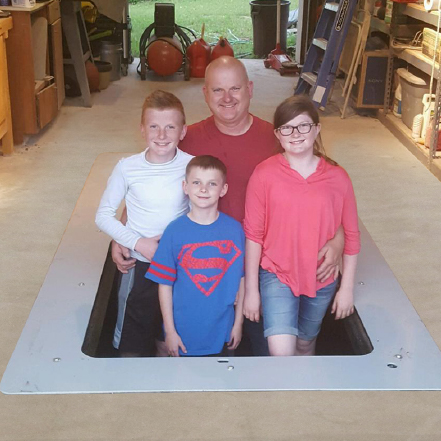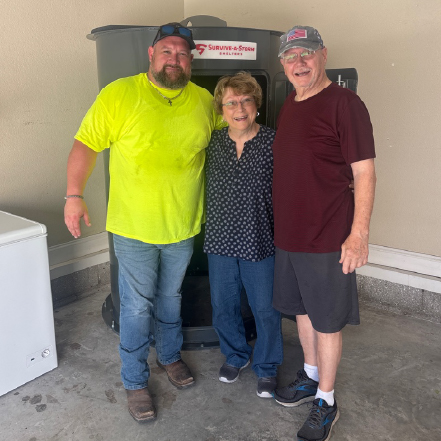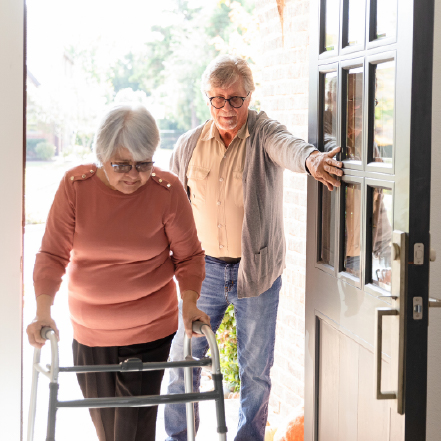CATEGORIES:
Tornado Safety for Infants and Elderly Family Members: A Guide for Families
September 23, 2025
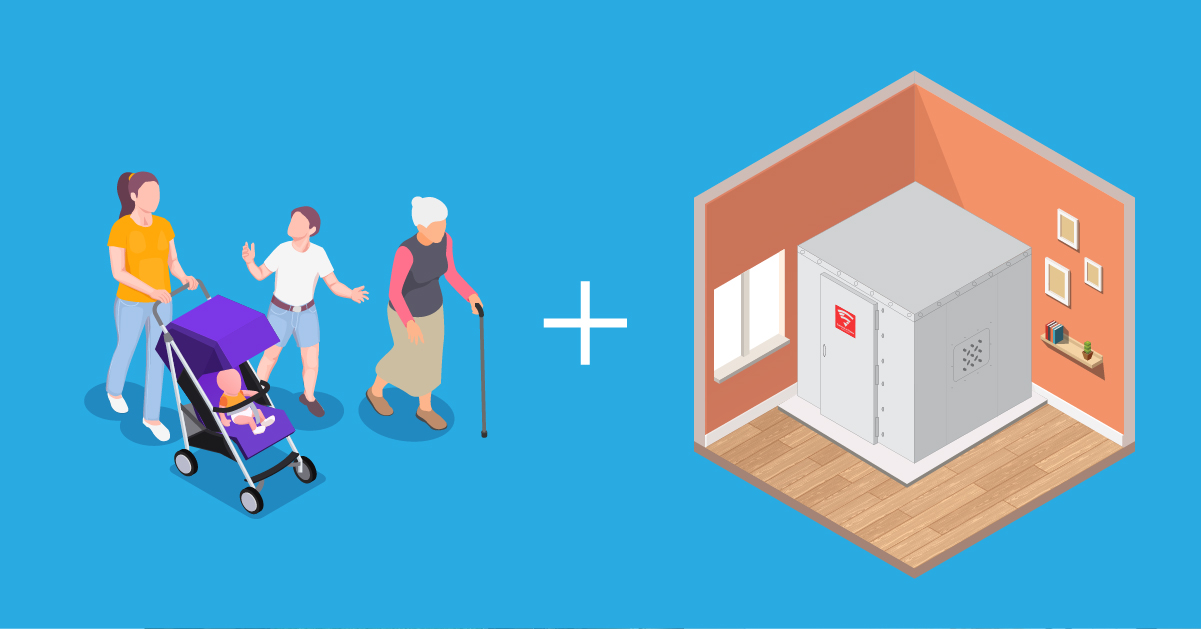
Absolute protection means thinking about those who need it most.
Why the Most Vulnerable Deserve Careful Planning for Tornado Safety
Tornadoes are among the most unpredictable natural disasters. And, as with other disasters, tornado preparedness isn't just about having flashlights and bottled water. Families often only have minutes after a tornado warning or sirens sound to get to the part of the building that they need to be. For families with infants and elderly loved ones, protecting the most vulnerable is top priority. Readiness means tailoring your plan to those who can’t protect themselves.
Infants and older adults are especially vulnerable during severe weather. Their unique needs make them far more likely to suffer serious injury, or worse, during extreme weather. According to population-adjusted data:
Infants may face the highest mortality risk among age groups after severe storms, including indirect effects in the months that follow.
Seniors over 75 face peak fatalities during tornadoes, heat waves, and hurricanes, especially in July and August.
The underlying reason? Individuals with limited mobility, sensory impairments, and cognitive challenges often struggle to take quick action when seconds matter most.
These numbers aren't just statistics; they're a call to action. If someone depends on you, your emergency plan should accommodate their needs.
For parents and caregivers, the challenge is making sure the needs of everyone are accounted for in the family’s tornado safety plan.
This guide provides practical tips to help families prepare, from creating emergency kits to choosing a shelter that works for all ages. Take a look here, download our checklist, but also look at other storm safety resources!
What Puts Infants and Elderly Family Members More At Risk?
To protect those who are most vulnerable, you first need to understand what makes them so. Infants and seniors may also struggle to recognize visual cues in the sky or be frightened by the freight-train-like roar that often accompanies a tornado.
Here’s why these age groups are especially vulnerable in storms:
| Risk Factor | Infants | Seniors |
|---|---|---|
| Mobility | Completely dependent on caregivers | May use walkers, canes, or wheelchairs |
| Sensory Processing | Limited sensory awareness | Vision or hearing loss |
| Cognitive Understanding | Too young to recognize danger | May have memory issues or disorientation |
| Independence | 100% dependent | May live alone or without active caregivers |
| Physical Resilience | Easily stressed by temperature or noise | At higher risk from heat, cold, or stress |
When storms strike, the time to react is limited, especially if it's the middle of the night and everyone is waking from a deep sleep. A safe spot is away from windows, in areas like a basement or interior closet or bathroom on the lowest level of the building. But, if your loved ones can’t move fast or understand what’s happening, your plan should close the gap before the storm hits.
Without quick protection, they risk serious injuries to the head, neck, or arms from flying debris.
Tornado Safety: Choosing a Shelter That Works for All Ages
The best storm shelter isn’t just safe, it’s accessible, calm, and functionally usable by everyone in your household. Every member of your family should know where the safest locations are. Preferably a storm shelter. They should be able to reach it, use it, and stay calm inside it.
A proper shelter is built to withstand extreme winds, flying debris, and even severe thunderstorms that often accompany tornadoes. Never shelter in a mobile home, under bridges or in a ditch during a tornado. Avoid seeking shelter in a car or truck, since vehicles are one of the worst places to be in a tornado. While an interior room of a building can be safe, well-built storm shelters and reinforced buildings provide far more protection than anywhere else.
Below is a handy checklist families with infants or elderly members.
What to Look for in an Accessible Shelter for Infants and Seniors
Wide doorways to accommodate strollers, walkers, or wheelchairs
Non-slip flooring or mats
Clearly lit paths with emergency lighting
Seating areas for seniors who can’t stand long
Temperature control and ventilation
Designated quiet areas for babies
Accessible restrooms or portable toilets nearby
Think of your shelter as a space to survive and as a place where your most vulnerable loved ones can safely endure a storm in safety and comfort.
Tornado Emergency Kits for Infants and Elderly Family Members
Luckily tornado events don't last long, but for many, they'll still include a supply of the following in their storm kit: food, water, shoes or other footwear, extra clothing (like long pants), sleeping bag, first-aid kit, phones, weather radio, backup batteries, electricity, emergency power supply and more.
Even with all of these supplies, standard emergency kits often fall short when it comes to babies or older adults. It's a great idea to ask each person in your family if there are things they'd like to have with them.
Here’s what to include for infants and seniors:
Infant Tornado Kit
Formula or breast milk (and sterile bottles)
Diapers, wipes, and diaper rash cream
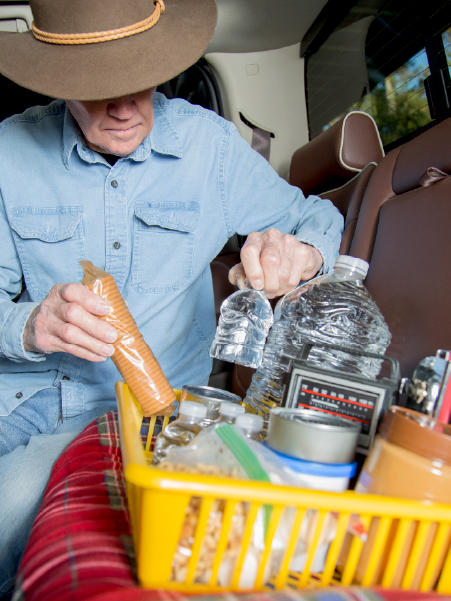 Pacifiers, soft blankets, and familiar comfort items
Pacifiers, soft blankets, and familiar comfort itemsBaby medications and thermometer
A baby carrier or sling for mobility
Tornado Kit for an Elderly Family Member
Prescription medications (and copies of prescriptions)
Hearing aids and batteries
Extra glasses or contacts
Personal hygiene items (toothbrush, wipes, etc.)
Walking aids, a seat cushion, and a warm blanket
List of emergency contacts and medical conditions (labeled in English so first responders can understand)
🧾 Tip: Store both kits in waterproof bags near your shelter location, so you're not scrambling when time is of the essence.
How to Evacuate or Shelter in Place with Infants and the Elderly
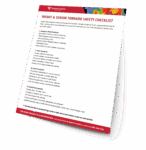 When the alert sounds, the way you move and communicate matters.
When the alert sounds, the way you move and communicate matters.
✅ Do:
Carry infants close to your body with a carrier to free your hands.
Assist elderly individuals slowly, using mobility aids.
Speak clearly and calmly to reduce panic.
Keep medications and medical gear within reach.
Offer reassurance. Your presence makes them feel safe.
❌ Don’t:
Rush or panic—this creates more confusion and risk.
Leave someone behind to grab more supplies.
Ignore signs of heat stress, confusion, or fear.
Overexert yourself when helping with mobility.
Your calm is contagious. In a storm, you are your family’s emotional anchor.
How to Involve Family Members in Tornado Planning (Without Overwhelming Them)
You don’t have to do it all alone, and you don’t have to wait until the last minute.
Create a simple, shareable plan using these steps:
Assign roles: Who assists Grandma? Who grabs the diaper bag? Parent can also assign children small roles, like helping with pets or calling friends to check in.
Encourage kids to ask questions. Their involvement makes the plan stick.
- Follow instructions from local authorities and share information with your neighborhood.
Create a list of local and out-of-state emergency contacts.
Choose two meeting points: one at home, one elsewhere.
Practice monthly tornado drills—even just walking through it helps.
Print and distribute copies of your tornado safety plan to family, babysitters, and caregivers.
A little clarity goes a long way when time is tight and emotions run high.
Tornado Safety After The Storm
After the storm, watch for downed trees, damaged utility lines, fallen power lines, and gas leaks that could spark a fire. Check reliable news, official updates, or even verified YouTube channels for recovery information and information about damage in your neighborhood. Hopefully the worst is over, but keep in mind that there still could be more storms in the area that carry hail and high winds. Keep your ear to the ground for further warnings.
If you know basic CPR and first aid, prepare to use that knowledge to assist with injuries - just in case. Remember that you're part of a community that includes infants, children, pets, and elderly neighbors. You all rely on each other for protection.
Tornado Safety Planning Is Love in Action
You already do so much to care for the people you love. Having a storm plan is just one more way to say, “I’ve got you.”
Protecting infants and elderly family members in a tornado isn’t about perfection; it’s about intentional, thoughtful planning that centers their needs. Because absolute protection starts with those who need it most.
✅ Download Our Infant & Senior Tornado Safety Checklist now and make sure your storm plan is ready for every member of your family—especially the ones who depend on you most.



